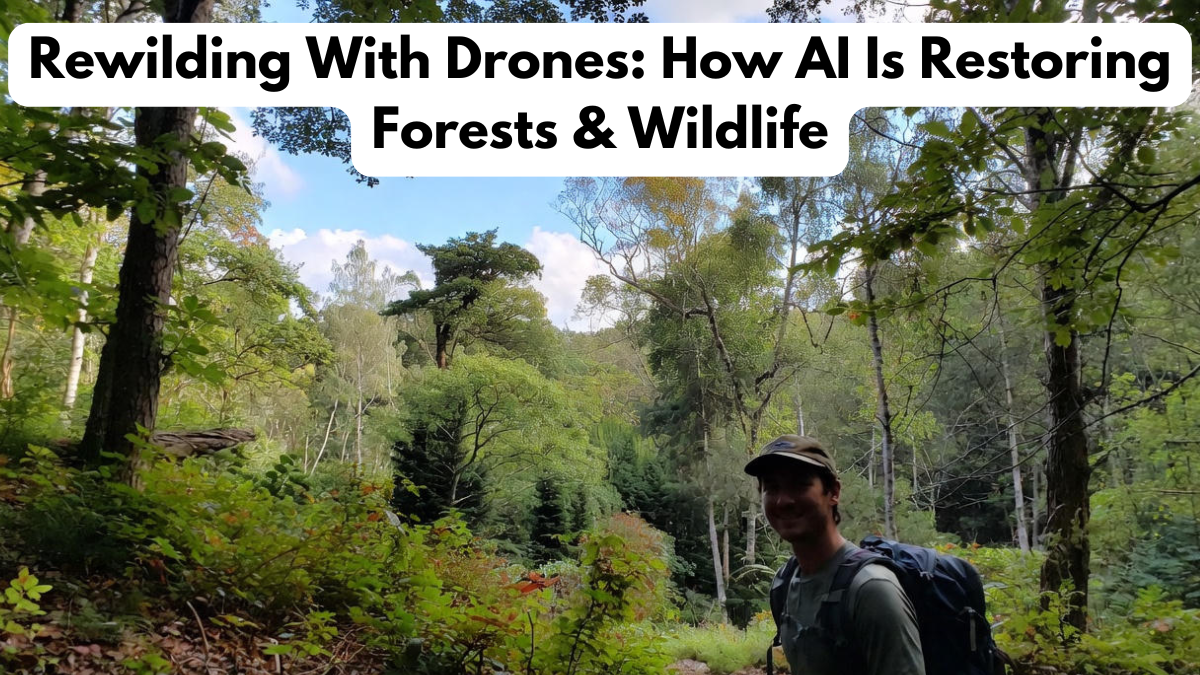Environmental restoration is entering a revolutionary phase with the rise of rewilding drones, a fast and highly efficient technology designed to revive fragile habitats. As ecosystems suffer from deforestation, climate change, and biodiversity loss, the need for rapid restoration methods has become more urgent than ever. Supported by powerful AI environment systems, rewilding drones can plant seeds, monitor wildlife, analyze soil, and track ecological recovery with unprecedented precision. This combination of automation and artificial intelligence is reshaping the way conservationists rebuild nature.

How Rewilding Drones Are Transforming Ecological Restoration
Traditional reforestation and wildlife restoration efforts often require large teams, extensive funding, and years of manual labor. Rewilding drones eliminate many of these limitations by covering large areas quickly, accessing remote regions, and performing specialized tasks without physical strain. Equipped with intelligent AI environment technology, these drones can identify ideal planting zones, detect ecosystem threats, and determine the best strategy for restoring biodiversity.
Drones designed for rewilding can carry seed pods, disperse them strategically, and track growth patterns over time. They can also survey wildlife populations without disturbing their natural behavior. With the support of AI environment analytics, these machines offer actionable insights that help conservationists plan more effective restoration programs.
Technology Behind Drone-Based Rewilding
The effectiveness of rewilding drones depends on a combination of environmental sensors, flight automation, and intelligent decision-making algorithms. These drones are built to withstand harsh terrains, unpredictable climates, and dense forestry. The integration of AI environment systems enables them to interpret environmental conditions and adjust their tasks in real time.
Below is a table highlighting the key technologies used in rewilding drones:
| Technology | Function | Benefit |
|---|---|---|
| Seed Deployment Pods | Deliver seeds into soil | Speeds up reforestation efforts |
| AI Environment Sensors | Analyze soil, moisture, and climate | Guides accurate planting decisions |
| Aerial Mapping Systems | Create 3D maps of ecosystems | Helps track wildlife and vegetation growth |
| Automated Flight Controls | Navigate difficult terrains | Ensures precision and safety |
| Wildlife Monitoring Cameras | Capture animal activity | Supports conservation planning |
These powerful capabilities allow rewilding drones to restore habitats more efficiently than ever before. With the deep learning capabilities of AI environment systems, drones can learn ecosystem behavior and continuously improve restoration outcomes.
Benefits of Rewilding Drones for Conservationists
The adoption of rewilding drones has proven to be a game changer for environmental organizations, researchers, and governments aiming to rebuild damaged landscapes. When combined with advanced AI environment insights, drones provide a faster, cheaper, and more accurate alternative to traditional methods.
Key benefits include:
- Rapid planting of thousands of seeds per day
- Ability to reach remote or dangerous locations
- Reduced human labor and cost
- Improved monitoring of ecosystem recovery
- Accurate environmental data analysis
- Enhanced wildlife protection and tracking
- Strong support from AI environment systems
These advantages enable restoration teams to implement large-scale recovery projects that were once considered logistically impossible. As the technology becomes more affordable, rewilding drones will expand into global conservation programs.
Future Potential of AI-Driven Rewilding Technology
The future of rewilding drones is incredibly promising. New generations of drones will be able to not only plant seeds but also water them, deliver nutrients, remove invasive species, and create artificial habitats for endangered wildlife. With more advanced AI environment tools, drones will autonomously assess ecosystem development, predict potential threats, and recommend solutions without human intervention.
Upcoming innovations may include swarm drone technology—multiple drones working together to restore large landscapes in coordinated formations. Additionally, drones may collaborate with ground robots to ensure long-term ecological monitoring. As environmental challenges grow, rewilding drones supported by strong AI environment infrastructures will play a crucial role in restoring balance to the planet.
Conclusion
The rise of rewilding drones represents a groundbreaking shift in environmental restoration. By pairing automated aerial technology with intelligent AI environment systems, conservationists can restore forests, revive wildlife habitats, and rebuild ecosystems faster than ever before. This innovative approach provides a hopeful future where technology and nature work hand in hand to heal the planet. As the world embraces sustainable solutions, rewilding drones will continue to lead the way toward restoring natural ecosystems efficiently and intelligently.
FAQs
What are rewilding drones?
Rewilding drones are automated aerial devices designed to restore natural habitats by planting seeds and monitoring ecosystems using AI environment technology.
How do rewilding drones help the environment?
They speed up reforestation, track wildlife, and analyze ecological conditions with the help of AI environment systems.
Are rewilding drones better than manual planting?
Yes, rewilding drones can plant thousands of seeds rapidly and reach areas that are unsafe or difficult for humans.
Can drones monitor wildlife?
Absolutely. With AI environment sensors and cameras, drones can observe animals without disturbing their habitat.
Will rewilding drones play a major role in future conservation?
Yes, rewilding drones are expected to become essential tools in global restoration efforts due to their speed, accuracy, and AI-driven insights.
Click here to learn more